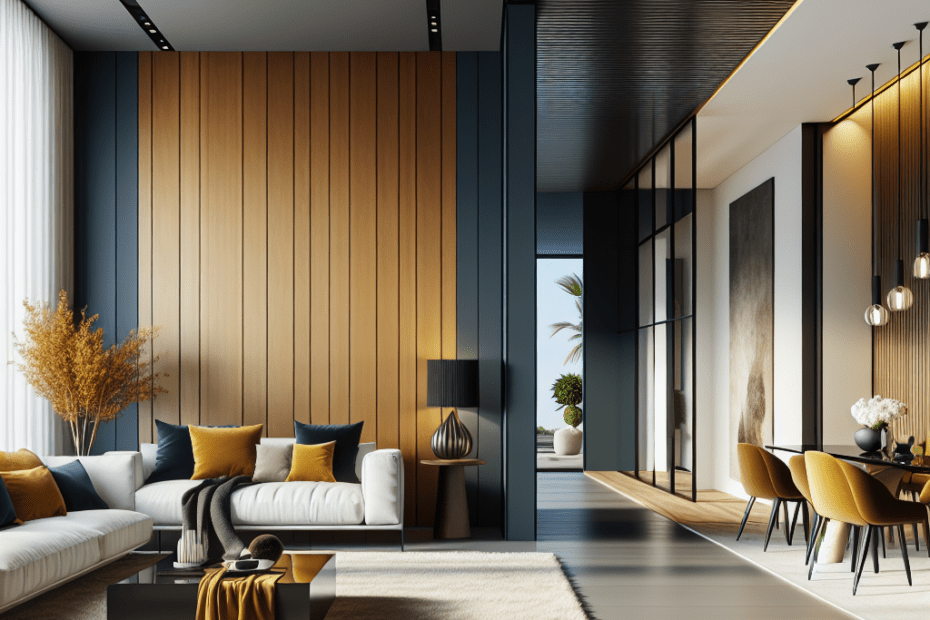“`html
The Power of Accent Walls in Modern Home Design
In the world of interior design, homeowners and designers alike are continuously searching for creative and effective ways to transform spaces. One of the most impactful tools they use is the accent wall. Accent walls have grown in popularity in modern home design because they offer a striking and bold statement without overwhelming a room. By focusing on a single wall, they create a focal point, draw the eyes, and can even change the perceived dimensions of a space. But why are accent walls so powerful, and how can they benefit a home’s interior design?
What Are Accent Walls?
An accent wall is a single wall within a room painted or decorated differently from the others. This variance is crafted to highlight or contrast with the space’s overall design. Designers might use a contrasting paint color, vibrant wallpaper, textured materials like stone or wood, or even a gallery wall filled with artwork or photographs to achieve this effect. The goal is to add depth, interest, and a personalized touch to any room.
Why Choose an Accent Wall?
Choosing an accent wall can offer numerous benefits for home decorators. According to a 2022 survey conducted by Houzz, 54% of interior designers recommend using accent walls to update a room’s look without a complete overhaul. This makes them both a cost-effective and visually impactful design choice.
Statistic Table: Design Trends with Accent Walls
| Design Trend | Percentage of Designers Using |
|---|---|
| Use of Complimentary Colors | 45% |
| Incorporation of Wallpaper | 30% |
| Integration of Textured Materials | 25% |
The Visual Impact of Accent Walls
Accent walls can drastically alter the mood or tone of a space. For example, warm colors like red or orange can make a room feel cozy and inviting, while cool colors such as blue or green can provide a serene and calming effect. According to the American Society of Interior Designers (ASID), color psychology plays a critical role in how individuals perceive and interact with their environments, making the choice of color and texture on accent walls more than just an artistic preference.
Practical Benefits of Accent Walls
Aside from the aesthetic advantages, accent walls also offer several practical benefits. They can:
- Provide a cost-effective way to revamp a room without the need for new furniture or expensive renovations.
- Help delineate spaces in an open floor plan, subtly defining areas for different uses.
- Hide imperfections or highlight architectural features in a room.
Common Mistakes to Avoid
While accent walls are an excellent design tool, they need thoughtful execution. Here are some common mistakes to avoid:
- Overuse: Too many accent walls in a home can overwhelm the space and reduce their impact.
- Poor Color Choices: Choosing a color that clashes with existing decor can create an unharmonious look.
- Ignoring Lighting: Not considering how natural and artificial light affects the wall’s appearance can lead to unexpected results.
Creating Your Own Accent Wall
Creating an accent wall is an achievable DIY project for most homeowners. They need only decide on the right wall and design elements. Professionals recommend starting with paint, as it is the most affordable and reversible option. Homeowners seeking to make a bolder statement might venture into wallpaper or textured materials. It’s always wise to gather samples and test them within the space before committing to a full application.
Key Takeaways
- Accent walls effectively create focal points and depth in a room.
- They offer a cost-efficient solution for renovating spaces without extensive remodeling.
- When thoughtfully executed, they can beautifully enhance a home’s aesthetic.
- Designers emphasize consideration of color psychology and lighting impacts when planning an accent wall.
- DIY enthusiasts can experiment with different materials and styles to personalize their rooms.
Frequently Asked Questions (FAQ)
- What is the main purpose of an accent wall?
An accent wall serves to highlight or contrast a particular area within a room, grabbing attention and providing visual interest. - How do they choose which wall to accent?
Typically, designers select the first wall viewed upon entering a room or one with distinct architectural features to focus on. - Are there any specific rooms where accent walls work best?
While effective in many rooms, living rooms, bedrooms, and dining areas benefit the most due to their social and relaxing purposes. - Can they change my room’s feel or size perception?
Yes, certain colors and patterns can make rooms feel larger, smaller, warmer, or cooler, affecting the ambiance significantly. - What are some modern trends for accent walls?
Current trends include using bold, dark colors, geometric patterns, and textured panels like shiplap or reclaimed wood.
“`
Accent walls offer a powerful way to shape and define spaces, aligning seamlessly with modern home design trends. Whether through bold colors or textured materials, they can enhance a home’s aesthetics, providing both beauty and practicality.
